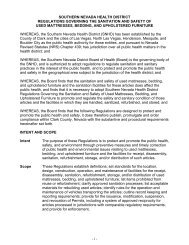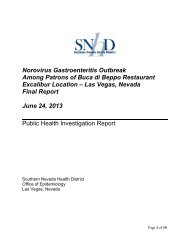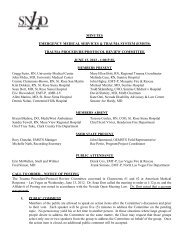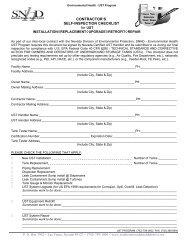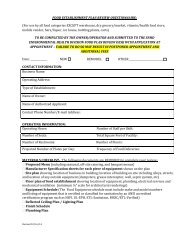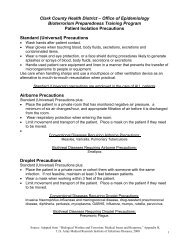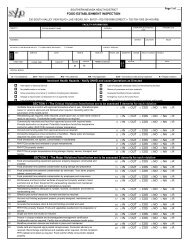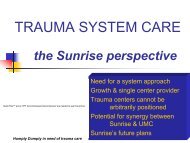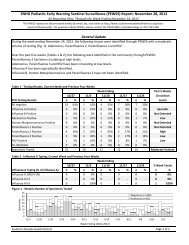Current Trauma Status Report - Southern Nevada Health District
Current Trauma Status Report - Southern Nevada Health District
Current Trauma Status Report - Southern Nevada Health District
You also want an ePaper? Increase the reach of your titles
YUMPU automatically turns print PDFs into web optimized ePapers that Google loves.
Triage Criteria<br />
The determination of whether an injured patient needs to be transported to a trauma center is made<br />
based on specific triage criteria. These are enumerated in the Clark County <strong>Health</strong> <strong>District</strong>’s trauma<br />
patient destination protocol, a new version of which was implemented on April 1, 2004. The new<br />
version exactly matches the protocol described in the <strong>Nevada</strong> Administrative Code (NAC 450B.770),<br />
whereas the previous Clark County <strong>Health</strong> <strong>District</strong> protocol had contained slight differences.<br />
Among the changes, the new protocol reduces the speed with which a pedestrian needs to be hit to be<br />
transported to a trauma center from 20 miles per hour to 6 miles per hour and adds the requirement<br />
stipulated in the NAC that patients be transported to the highest level trauma center available within<br />
30 minutes. The new protocol originally called for motor vehicle crash patients traveling at a speed of<br />
at least 20 miles per hour to be transported to a trauma center, as stated in the NAC. (Previously the<br />
threshold in Clark County had been 40 miles per hour.) However, the Clark County <strong>Health</strong> <strong>District</strong> has<br />
received a variance with the State Board of <strong>Health</strong> to have this changed back to 40 miles per hour,<br />
given concerns of over-triage with the 20 mile per hour threshold.<br />
Transport Agencies<br />
There are an adequate number of ambulances for timely transport of patients to the appropriate<br />
facilities, but a major impact on the resources for ambulance services is the lengthy delays incurred at<br />
the hospitals to off load their patients. There may be as many as 5-6 ambulances backed up at any one<br />
hospital waiting for the hospital to assume responsibility and care for the patient. Delays average 50<br />
minutes and recent data suggests that 90 percent of the time it takes 70 minutes for the hospital to<br />
assume care of the patient . This leaves an ambulance out of service for hours.<br />
Clark County <strong>Health</strong> <strong>District</strong> has implemented EMSystem software to track hospital closures and<br />
ambulance backup. The problem has been evaluated at various committees for years as well as the QI<br />
Committee but a long-term workable solution has not been developed. The community is now pilot<br />
testing eliminating the “emergency department closure” protocol for 90 days. Initial results are<br />
positive.<br />
Mutual aide agreements exist between EMS providers in <strong>Southern</strong> <strong>Nevada</strong>. There is also an Automatic<br />
Aide System established for the region. Through the use of a satellite GPS system, the closest unit will<br />
be dispatched to the scene, which may take the unit out of their designated service area. Agreements<br />
are not maintained or supervised by the EMS Office but are kept at the provider agencies.<br />
Emergency Preparedness<br />
While there is no separate EMS Disaster Plan, EMS is part of the area wide plan for mass casualty<br />
disaster, which includes plans for terrorist incidents and hazardous materials management. There has<br />
been extensive disaster and bioterrorism planning for the region. The area wide planning includes<br />
EMS, local government, the private sector and acute care facilities. They are all members of the Local<br />
Emergency Planning Committee (LEPC). The last update of the Mass Casualty Plan was completed in<br />
June 2003.<br />
Page 34



